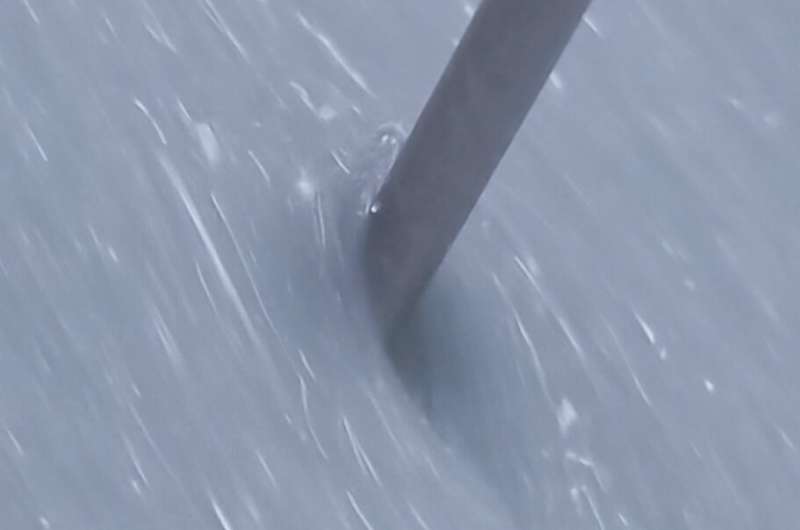by B. Darbois Texier, Y. Bertho and P. Gondret
One way to reduce the damage caused by avalanches in the mountains is to place obstacles in their path. These obstacles can be artificial barriers or natural forests. Knowing how the avalanche interacts with obstacles is essential to mitigate the damage from snow avalanches as well as other hazardous geophysical granular flows such as debris flows or mudslides.
We (a team of researchers from the laboratory FAST in Paris-Saclay University) were inspired by this issue and developed a model experiment on a smaller scale to investigate the interaction between a granular material flowing down an inclined plane and a forest of pillars. Our plane is about one meter long and half a meter wide and is covered by a forest of pillars, typically 2 mm in diameter and with a regular spacing of 1 cm. The grains used are glass beads of 0.5 mm diameter, like sand but spherical in shape.
We deduce the instantaneous flow rate from a balance connected to a computer which gives the weight of the grains falling at the end of the plane as a function of time. The thickness of the flow is controlled upstream by fine-tuning the opening of the feed tank and is measured downstream from an inclined laser sheet.
With this setup, we measured the steady flow rate of grains that establishes through the forest of pillars for different slope inclinations, thicknesses of the granular layer and, most importantly, distances between the pillars. Our measurements show that the flow rate of grains increases with the slope angle, and the layer thickness and decreases with the density of pillars present in the incline.
Surprisingly, the presence of pillars reduces the granular flow rate in a non-trivial way, while in the absence of pillars, the granular flow rate increases rapidly with the layer thickness; at large density of pillars, the granular flow rate becomes virtually independent of the thickness of the granular layer. Thus, the presence of pillars significantly modifies the dependency of the granular flow rate with the parameter of the experiments.

Granular flow through a forest of pillar. © University Paris-Saclay / FAST
Then we developed a theoretical model to rationalize their observations. The flow of grains is considered through a depth-averaged approach and the classical μ(I) rheology which has been introduced to describe dense granular flows. In addition, we considered an expression for the force applied by each pillar on the granular layer and added the contribution of each pillar to obtain an average estimate of their effects.
This approach gives predictions in good agreement with the observations in the wide range of parameters studied in this project. This means that we are now able to predict the effect of multiple obstacles present in the path of a granular flow. By transposing the predictions of this model to an avalanche of material one meter thick through a forest of trees 20 cm in diameter, we predict that the presence of a forest attenuates the avalanche if the spacing between trees is less than 3 meters. We have published our research in the journal Physical Review Fluids.

Granular flow through around a single pillar. © University Paris-Saclay / FAST
This study corresponds to a first step in characterizing the interaction between a granular flow running down a slope and a forest of obstacles. Several points can be explored to improve the description of this interaction between the avalanche and the obstacles. We should go beyond the average approach and observe how the presence of obstacles modifies the granular flow locally, in their vicinity.
We also need to study the effect of the spatial distribution of pillars on the attenuation of the granular flow. Another possible stage of investigation will be to characterize the effect of cohesion of the grains on the global flow. These possibilities aim to get closer to real-life situations and take into account the cohesive properties of snow and the spatial distribution of trees in forests.
This story is part of Science X Dialog, where researchers can report findings from their published research articles. Visit this page for information about ScienceX Dialog and how to participate.
More information:
Baptiste Darbois Texier et al, Downslope granular flow through a forest of obstacles, Physical Review Fluids (2023). DOI: 10.1103/PhysRevFluids.8.034303
Baptiste Darbois Texier is a researcher in fluid mechanics at the FAST laboratory of the University of Paris-Saclay and leads an experimental approach on dense granular flows and particle suspensions.
Citation:
How forest density slows granular flows (2023, April 11)



